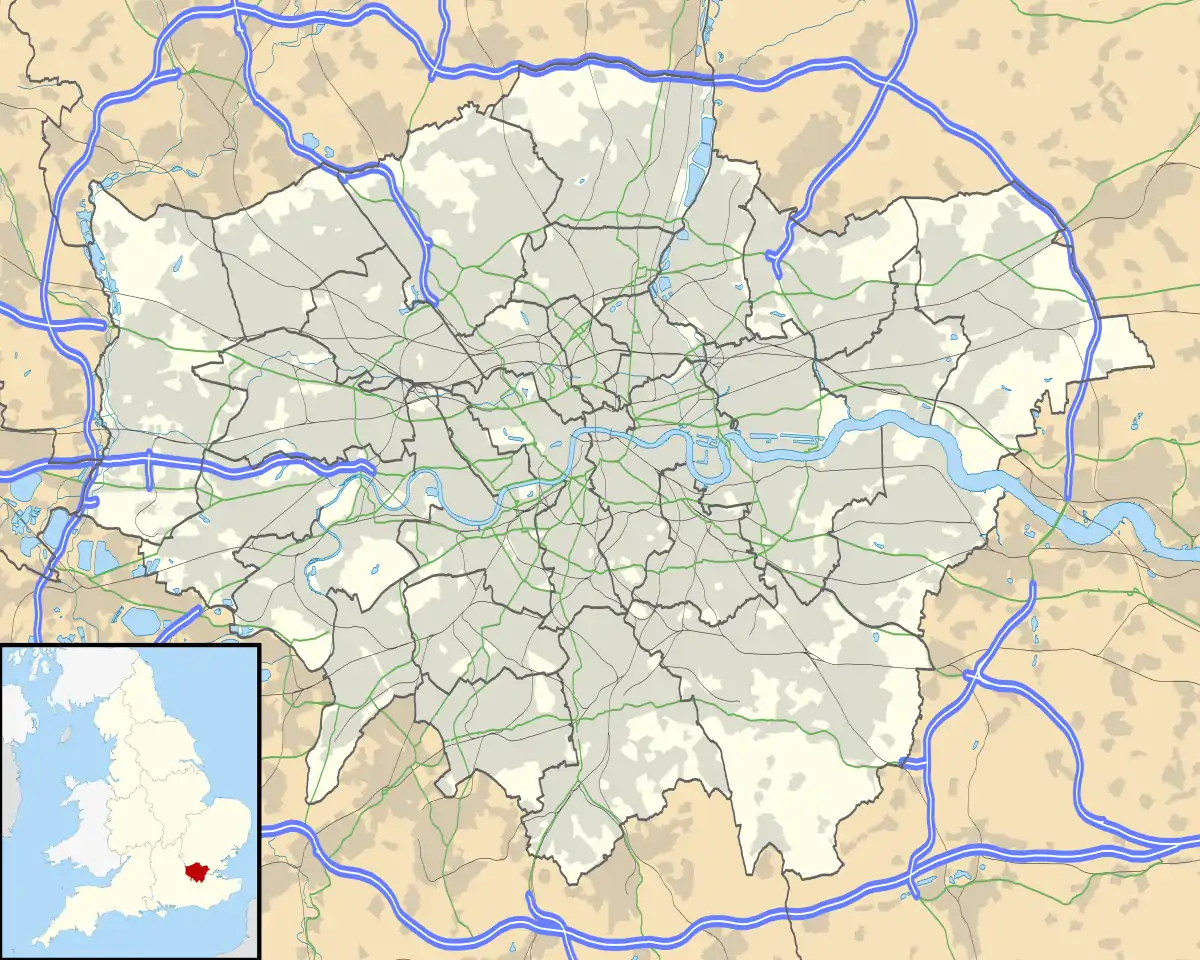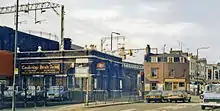Cambridge Heath railway station
Cambridge Heath is a railway station operated by London Overground[2][3] in Bethnal Green, East London. The station is 1 mile 61 chains (2.8 km) down the line from London Liverpool Street and is situated between Bethnal Green and London Fields on the Lea Valley lines to Cheshunt and Enfield Town. Its three-letter station code is CBH and it is in Travelcard zone 2.
| Cambridge Heath | |
|---|---|
 Cambridge Heath railway station in 2010 | |
 Cambridge Heath Location of Cambridge Heath in Greater London | |
| Location | Bethnal Green |
| Local authority | London Borough of Tower Hamlets |
| Managed by | London Overground |
| Owner | Network Rail |
| Station code | CBH |
| DfT category | F1 |
| Number of platforms | 2 |
| Fare zone | 2 |
| National Rail annual entry and exit | |
| 2015–16 | |
| 2016–17 | |
| 2017–18 | |
| 2018–19 | |
| 2019–20 | |
| Railway companies | |
| Original company | Great Eastern Railway |
| Pre-grouping | Great Eastern Railway |
| Post-grouping | London and North Eastern Railway |
| Key dates | |
| 27 May 1872 | Station opened |
| 22 May 1916 | Temporarily closed |
| 5 May 1919 | Reopened |
| 17 February 1986 | Temporarily closed |
| 15 March 1986 | Reopened |
| Other information | |
| External links | |
| WGS84 | 51.5321°N 0.0572°W |
The station is named after the Cambridge Heath area of Hackney across Hackney Road.
History
Great Eastern Railway 1872-1922
The station was opened on 27 May 1872 by the Great Eastern Railway (GER) as part of a more direct route to Enfield Town which before opening was accessed via Angel Road station. When built the station, which is built on a viaduct, had two platforms and a station building on the east side. in 1894 with increasing traffic, the GER opened two additional tracks on the eastern side of the station which are known as the Fast Lines today and allow longer distance trains to pass trains that stop at Cambridge Heath.[4][5]
No platforms were ever built on these new lines. The 1872 station building was demolished and a new building to the east of the new tracks was built with the platforms accessed through a foot tunnel.
During World War I the station was closed as a wartime economy measure from 22 May 1916 reopening on 5 May 1919.[6]
London & North Eastern Railway (1923-1947)
After the Railways Act 1921 the country's railways were grouped into four companies, with effect from 1 January 1923. At Hackney Downs the London & North Eastern Railway (LNER) took over operations of the GER services. The semaphore signalling was replaced by single searchlight signals which were able to display three-aspects (Green, Yellow or Red) through different a changeable lens arrangement, in 1935. It was also in 1935 that electrification of the lines through Cambridge Heath was suggested, although many years were to pass before these plans came to fruition.[7][8]
British Railways (1948-1994)
On nationalisation in 1948 responsibility for operating the station fell to British Railways (Eastern Region).
The lines through Hackney were electrified in the late 1950s with electric services commencing operation on 21 November 1960.[9]
The privatisation era (1994-present day)
The station, along with neighbouring London Fields, was for many years only served during weekday peak periods, with regular daytime services not restarting until 1998, and evening and Saturday services from 2001.[10]
Oyster pay as you go cards were introduced at the station in 2008. The station and all services that call were previously operated by Abellio Greater Anglia. In 2015 Cambridge Heath transferred to London Overground and now appears on the tube map.[11][12]
As of November 2018, the station will take part in a "pay by face" facial technology trial called "Gateless Gatelines". It will be used for a trial to "nudge" passengers into ensuring they tap their payment card.[13] In the three-month data-gathering exercise 3D mapping "stereoscopic depth sensors" resembling ceiling-mounted shower heads will track people's movements. The system will be able to analyse from a person's movement through the gate whether they have touched in on the Oyster reader."[13]
Services
The typical weekday off-peak service from Cambridge Heath is four trains per hour southbound to London Liverpool Street and two trains per hour northbound to Cheshunt and two to Enfield Town. Service frequency is increased at peak times.[14] London Overground services to Chingford pass by on the fast lines.

Connections
London Buses services serves the station, key routes 26, 48, 55, 254, 388, local routes 106 and D6, night routes N26, N55 and N253.
References
- "Station usage estimates". Rail statistics. Office of Rail Regulation. Please note: Some methodology may vary year on year.
- "Cambridge Heath (London) Rail Station". Transport for London.
- "National Rail Enquiries - Station facilities for Cambridge Heath". nationalrail.co.uk.
- Taylor, D J (July 1990). "Camnridge Heath Station". Great Eastern Journal. 63: 11.
- Wilson, Bryan (October 2002). "Hackney Downs Station, Middlesex". Great Eastern Journal. 112: 21, 22.
- Chronology of London Railways by H.V.Borley
- Unknown, letter (April 2003). "A-Z of GER stations Hackney Downs Station, Middlesex". Great Eastern Journal. 114: 57.
- Wilson, Bryan (October 2002). "Hackney Downs Station, Middlesex". Great Eastern Journal. 112: 22.
- Wilson, Bryan (October 2002). "Hackney Downs Station, Middlesex". Great Eastern Journal. 112: 25.
- Cambridge Heath and London Fields RUG - A Brief History of Cambridge Heath & London Fields www.railwatch.org; Retrieved 9 January 2014
- "TFL appoints London Overground operator to run additional services" (Press release). Transport for London. 28 May 2014.
- "TfL count on LOROL for support". Rail Professional. 28 May 2014.
- Blunden, Mark (22 November 2018). "Could scanners like these solve tube and train crowds". Evening Standard. London.
- Table 21 National Rail timetable, May 2019
External links
 Media related to Cambridge Heath railway station at Wikimedia Commons
Media related to Cambridge Heath railway station at Wikimedia Commons
- Train times and station information for Cambridge Heath railway station from National Rail
| Preceding station | Following station | |||
|---|---|---|---|---|
towards Liverpool Street | Enfield & Cheshunt Line |